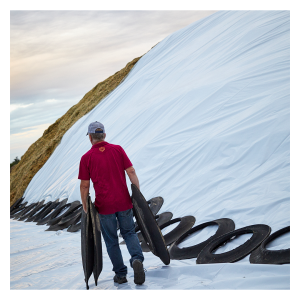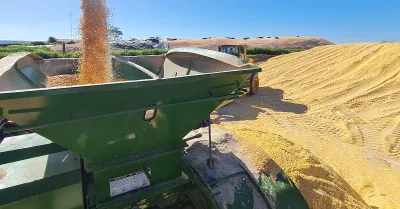Nothing Beats a Good Cover
Protect your silage harvest with a good plastic cover. Here’s why: A high-yielding harvest is the ideal goal for any farmer, but when it comes to silage, harvest is only half the battle. Once you have your pile planned and in place, you need to keep your silage safe and nutritious for your animals. Using the proper covering is the primary way to do so.

But what options are available for pile coverings?
And what best practices should you have in place to make sure those coverings are as effective as possible in keeping oxygen out of your silage so that proper fermentation can take place?
Well, you might say we have you…covered.
First and foremost, it’s important to cover your pile as soon as possible when you are done adding to it. The longer you delay, the more chance the pile has of being contaminated with oxygen or debris.
Immediately cover the pile with a cover to act as an oxygen barrier. The ideal pile cover is overlapping layers of polyethylene plastic. Just note that not all polyethylene is created equal. We recommend a 6-8-millimeter-thick film with ultraviolet protection. Reinforced polyethylene is the best because it adds ultraviolet protection as well as some protection from chemical dangers.
If you can’t use reinforced polyethylene, a low-density polyethylene can work as well.
Spring For the Poly
It’s true that almost any cover is better than no cover at all, but if you opt to save some money and use an inexpensive, non-polyethylene cover, you will almost certainly let water and air into your silage. The question isn’t “Will you see spoilage?” but “How deep will the spoilage go?” So be advised that if you opt for an inexpensive tarp, say one made of woven material, any money you save up front will cost you in the end through spoilage, loss of dry matter or worse.
Some have tried more “natural” covers like layers of soil limestone or sawdust but they are largely ineffectual at keeping water and air out of your silage. Others have opted for nylon or even PVC materials, but both offer major disadvantages in protecting silage and livestock. Nylon simply isn’t strong enough and will likely tear if it’s dragged around a lot, meaning you could have breaches where you weren’t expecting. Meanwhile, PVC sheets seem like they could work but they can seep chemicals into your silage, which can be extremely unhealthy for your cows.
Doesn’t Hurt to Double Up
If you opt for a polyethylene cover that doesn’t offer UV protection, we recommend a second cover made of sun-blocking white or black plastic to protect the inner cover from the sun.
After your cover material is chosen, be sure to overlap each sheet by at least 6 feet, weight it down properly and anchor the bottom edges using sandbags. We stress sandbags because they allow water runoff to seep through onto the ground, as opposed to pooling up along the edges and possibly running back under the cover.

If you would like to learn more about covering or pile planning, schedule to speak with one of our silage experts today HERE or read our BLOG article about Pile Planning.


